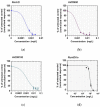Outstanding Antibacterial Activity of Hypericum rochelii-Comparison of the Antimicrobial Effects of Extracts and Fractions from Four Hypericum Species Growing in Bulgaria with a Focus on Prenylated Phloroglucinols
- PMID: 36836632
- PMCID: PMC9959064
- DOI: 10.3390/life13020274
Outstanding Antibacterial Activity of Hypericum rochelii-Comparison of the Antimicrobial Effects of Extracts and Fractions from Four Hypericum Species Growing in Bulgaria with a Focus on Prenylated Phloroglucinols
Abstract
Microbial infections are by no means a health problem from a past era due to the increasing antimicrobial resistance of infectious strains. Medicine is in constant need of new drugs and, recently, plant products have had a deserved renaissance and garnered scientific recognition. The aim of this work was to assess the antimicrobial activity of ten active ingredients from four Hypericum species growing in Bulgaria, as well as to obtain preliminary data on the phytochemical composition of the most promising samples. Extracts and fractions from H. rochelii Griseb. ex Schenk, H. hirsutum L., H. barbatum Jacq. and H. rumeliacum Boiss. obtained with conventional or supercritical CO2 extraction were tested on a panel of pathogenic microorganisms using broth microdilution, agar plates, dehydrogenase activity and biofilm assays. The panel of samples showed from weak to extraordinary antibacterial effects. Three of them (from H. rochelii and H. hirsutum) had minimum inhibitory concentrations as low as 0.625-78 mg/L and minimum bactericidal concentrations of 19.5-625 mg/L against Staphylococcus aureus and other Gram-positive bacteria. These values placed these samples among the best antibacterial extracts from the Hypericum genus. Some of the agents also demonstrated very high antibiofilm activity against methicillin-resistant S. aureus. Ultra-high-performance liquid chromatography-high-resolution mass spectrometry revealed the three most potent samples as rich sources of biologically active phloroglucinols. They were shown to be good drug or nutraceutical candidates, presumably without some of the side effects of conventional antibiotics.
Keywords: Hypericum; MRSA; S. aureus; bacterial biofilm; extracts; microbes; phytochemicals.
Conflict of interest statement
The authors declare no conflict of interest.
Figures












Similar articles
-
Chemical Composition and Biological Activity of Hypericum Species-H. hirsutum, H. barbatum, H. rochelii.Plants (Basel). 2024 Oct 17;13(20):2905. doi: 10.3390/plants13202905. Plants (Basel). 2024. PMID: 39458851 Free PMC article.
-
Unravelling Phytochemical and Bioactive Potential of Three Hypericum Species from Romanian Spontaneous Flora: H. alpigenum, H. perforatum and H. rochelii.Plants (Basel). 2022 Oct 19;11(20):2773. doi: 10.3390/plants11202773. Plants (Basel). 2022. PMID: 36297796 Free PMC article.
-
Antimicrobial studies on three species of Hypericum from the Canary Islands.J Ethnopharmacol. 2002 Jul;81(2):287-92. doi: 10.1016/s0378-8741(02)00083-1. J Ethnopharmacol. 2002. PMID: 12065165
-
Do other Hypericum species have medical potential as St. John's wort (Hypericum perforatum)?Curr Med Chem. 2013;20(18):2273-95. doi: 10.2174/0929867311320180001. Curr Med Chem. 2013. PMID: 23521674 Review.
-
A review of the antibacterial activity of Hypericum perforatum L.J Ethnopharmacol. 2010 Oct 5;131(3):511-21. doi: 10.1016/j.jep.2010.07.034. Epub 2010 Jul 24. J Ethnopharmacol. 2010. PMID: 20659547 Review.
Cited by
-
Effectiveness of a novel experimental herbal toothpaste against bacterial consortium associated with dental caries.J Clin Exp Dent. 2024 Jun 1;16(6):e670-e677. doi: 10.4317/jced.61356. eCollection 2024 Jun. J Clin Exp Dent. 2024. PMID: 39130367 Free PMC article.
-
Initiation of Apoptotic Pathway by the Cell-Free Supernatant Synthesized from Weissella cibaria Through In-Silico and In-Vitro Methods.Appl Biochem Biotechnol. 2024 Jul;196(7):4700-4724. doi: 10.1007/s12010-023-04688-3. Epub 2023 Sep 26. Appl Biochem Biotechnol. 2024. PMID: 37751008
-
Chemical Composition and Biological Activity of Hypericum Species-H. hirsutum, H. barbatum, H. rochelii.Plants (Basel). 2024 Oct 17;13(20):2905. doi: 10.3390/plants13202905. Plants (Basel). 2024. PMID: 39458851 Free PMC article.
-
Chitosan Membranes Containing Plant Extracts: Preparation, Characterization and Antimicrobial Properties.Int J Mol Sci. 2023 May 12;24(10):8673. doi: 10.3390/ijms24108673. Int J Mol Sci. 2023. PMID: 37240023 Free PMC article.
-
Liposomal Rifabutin-A Promising Antibiotic Repurposing Strategy against Methicillin-Resistant Staphylococcus aureus Infections.Pharmaceuticals (Basel). 2024 Apr 8;17(4):470. doi: 10.3390/ph17040470. Pharmaceuticals (Basel). 2024. PMID: 38675432 Free PMC article.
References
-
- O’Neill J. Tackling Drug-Resistant Infections Globally: Final Report and Recommendations: Review on Antimicrobial Resistance. Government of the United Kingdom; London, UK: 2016.
-
- Dorcheh F.A., Balmeh N., Sanjari S. In-silico investigation of antibacterial herbal compounds in order to find new antibiotic against Staphylococcus aureus and its resistant subtypes. Inform. Med. Unlocked. 2022;28:100843. doi: 10.1016/j.imu.2021.100843. - DOI
Grants and funding
LinkOut - more resources
Full Text Sources
Molecular Biology Databases
Miscellaneous

